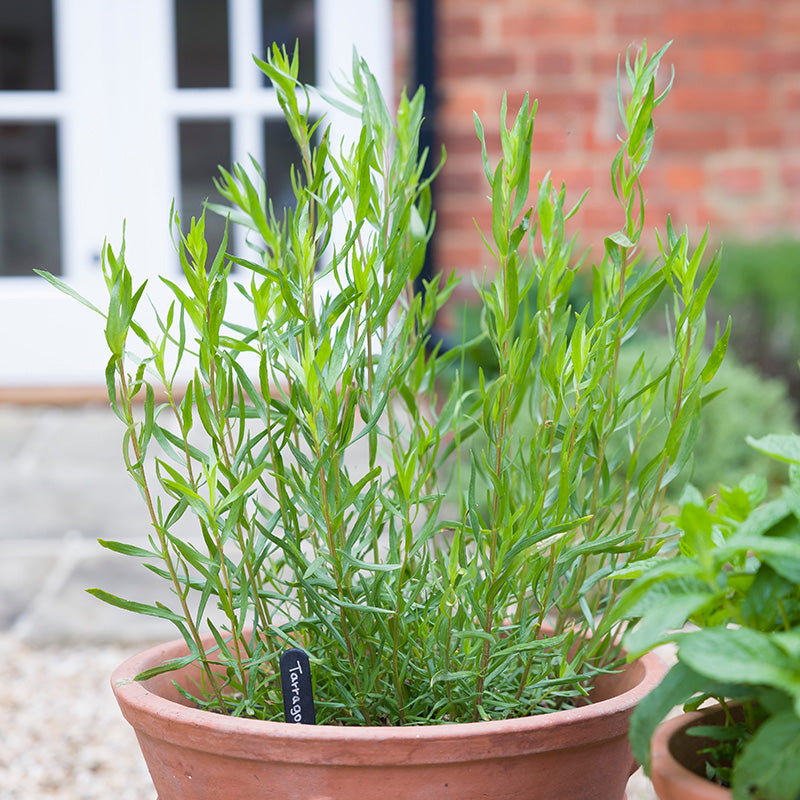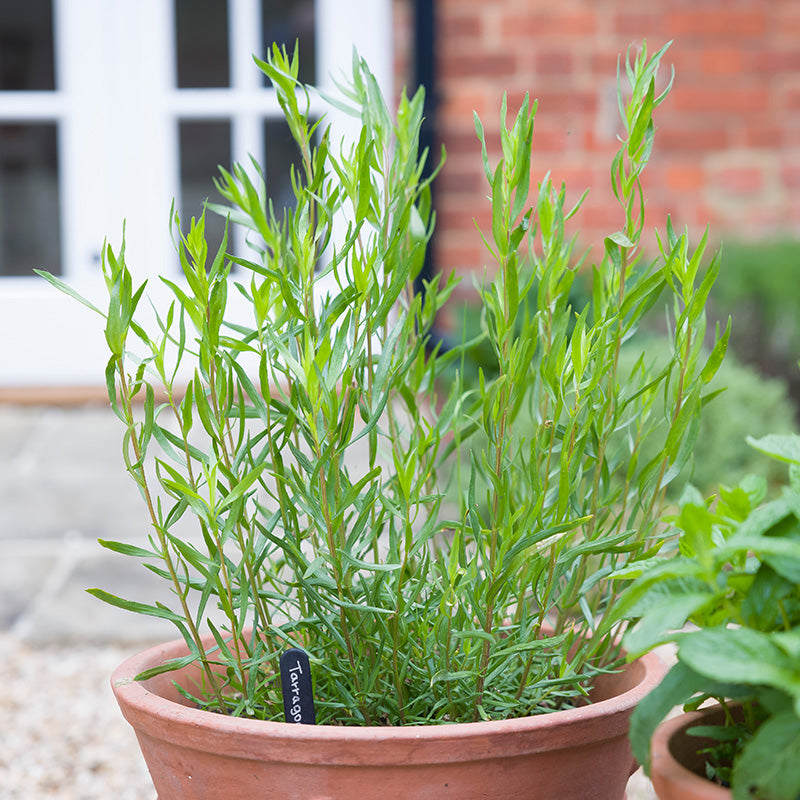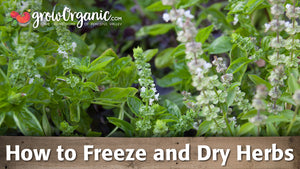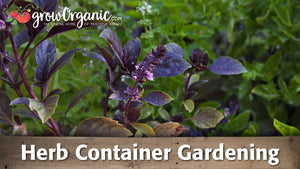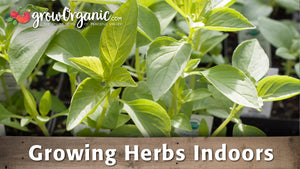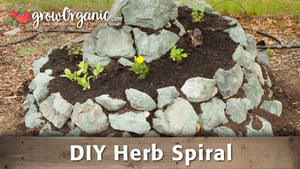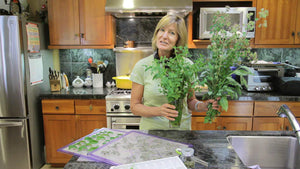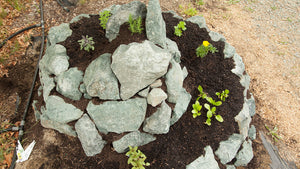Item Number: PV152
Organic French Tarragon
Organic French Tarragon
Delicate, Anise-Like Flavor
French Tarragon, scientifically known as Artemisia dracunculus, is a popular culinary herb prized for its distinctive flavor and aroma. Belonging to the Asteraceae family, this perennial herb is native to southern Europe and western Asia. French Tarragon is widely used in French cuisine, where it adds a delicate, anise-like flavor to dishes such as sauces, salads, and seafood.
Sustainably grown in 2.75" pots
Choosing the Right Location
When it comes to growing French Tarragon, selecting the right location is essential for its success. French Tarragon thrives in full sun to partial shade, preferring well-drained soil with a pH level between 6.5 and 7.5. Choose a site with good air circulation to prevent the development of fungal diseases. Avoid planting French Tarragon in areas with heavy clay soil or excessive moisture, as it can lead to root rot and other problems.
Planting French Tarragon
Plant French Tarragon in early spring or fall, spacing individual plants 18 to 24 inches apart to allow for proper growth and airflow. Dig a hole slightly larger than the root ball, and gently firm the soil around the plant.
Watering and Care
French Tarragon has moderate water needs and prefers consistent moisture throughout the growing season. Water newly planted French Tarragon regularly to establish strong roots, then transition to deep, infrequent watering once the plant is established. Avoid overwatering, as French Tarragon is susceptible to root rot in waterlogged soil. Mulching around the base of the plant can help retain soil moisture and suppress weeds.
Fertilizing
French Tarragon is not a heavy feeder and generally does not require fertilization if planted in nutrient-rich soil. However, you can apply a balanced fertilizer or compost in early spring to provide additional nutrients if needed. Be cautious not to over-fertilize, as excessive nitrogen can result in lush foliage at the expense of flavor. Monitor the growth of your French Tarragon plant and adjust fertilization accordingly.
Pruning and Harvesting
Regular pruning is essential for maintaining healthy French Tarragon plants and encouraging bushy growth. Pinch off the growing tips regularly to promote branching and prevent the plant from becoming leggy. Harvest French Tarragon leaves as needed throughout the growing season, using sharp scissors or pruning shears to snip off individual stems. Avoid harvesting more than one-third of the plant at a time to ensure continued growth and vitality.
Pest and Disease Management
French Tarragon is relatively pest and disease-resistant, but it may occasionally be affected by aphids, spider mites, or fungal diseases such as powdery mildew. Monitor your plants regularly for signs of pest infestations or disease symptoms, and take appropriate action to control them. Remove and destroy any affected plant parts, and consider using organic pesticides or fungicides as needed to protect your French Tarragon crop.
Overwintering
French Tarragon is a perennial herb that can survive mild winters with proper protection. In regions with cold winters, mulch around the base of the plant in late fall to insulate the roots and protect them from freezing temperatures. Alternatively, you can dig up potted French Tarragon plants and bring them indoors for the winter, where they can be grown as houseplants until spring.
Growing French Tarragon in your garden can be a rewarding experience, offering an abundant supply of fresh, aromatic leaves for culinary use. By following the guidelines outlined in this guide and providing proper care and attention, you can cultivate healthy French Tarragon plants that will thrive for years to come. Whether used to flavor sauces, salads, or seafood dishes, French Tarragon is sure to add a delightful touch to your culinary creations.





Check Your Zone Compatibility:
Compatible with your zone.
Growing Zone for
,

Our Guarantee To You
Since 1976, we've served our customers at every stage of growing. Please contact us at any time. We are happy to support and assist you.
Description
Description
French Tarragon, scientifically known as Artemisia dracunculus, is a popular culinary herb prized for its distinctive flavor and aroma. Belonging to the Asteraceae family, this perennial herb is native to southern Europe and western Asia. French Tarragon is widely used in French cuisine, where it adds a delicate, anise-like flavor to dishes such as sauces, salads, and seafood.
Sustainably grown in 2.75" pots
Choosing the Right Location
When it comes to growing French Tarragon, selecting the right location is essential for its success. French Tarragon thrives in full sun to partial shade, preferring well-drained soil with a pH level between 6.5 and 7.5. Choose a site with good air circulation to prevent the development of fungal diseases. Avoid planting French Tarragon in areas with heavy clay soil or excessive moisture, as it can lead to root rot and other problems.
Planting French Tarragon
Plant French Tarragon in early spring or fall, spacing individual plants 18 to 24 inches apart to allow for proper growth and airflow. Dig a hole slightly larger than the root ball, and gently firm the soil around the plant.
Watering and Care
French Tarragon has moderate water needs and prefers consistent moisture throughout the growing season. Water newly planted French Tarragon regularly to establish strong roots, then transition to deep, infrequent watering once the plant is established. Avoid overwatering, as French Tarragon is susceptible to root rot in waterlogged soil. Mulching around the base of the plant can help retain soil moisture and suppress weeds.
Fertilizing
French Tarragon is not a heavy feeder and generally does not require fertilization if planted in nutrient-rich soil. However, you can apply a balanced fertilizer or compost in early spring to provide additional nutrients if needed. Be cautious not to over-fertilize, as excessive nitrogen can result in lush foliage at the expense of flavor. Monitor the growth of your French Tarragon plant and adjust fertilization accordingly.
Pruning and Harvesting
Regular pruning is essential for maintaining healthy French Tarragon plants and encouraging bushy growth. Pinch off the growing tips regularly to promote branching and prevent the plant from becoming leggy. Harvest French Tarragon leaves as needed throughout the growing season, using sharp scissors or pruning shears to snip off individual stems. Avoid harvesting more than one-third of the plant at a time to ensure continued growth and vitality.
Pest and Disease Management
French Tarragon is relatively pest and disease-resistant, but it may occasionally be affected by aphids, spider mites, or fungal diseases such as powdery mildew. Monitor your plants regularly for signs of pest infestations or disease symptoms, and take appropriate action to control them. Remove and destroy any affected plant parts, and consider using organic pesticides or fungicides as needed to protect your French Tarragon crop.
Overwintering
French Tarragon is a perennial herb that can survive mild winters with proper protection. In regions with cold winters, mulch around the base of the plant in late fall to insulate the roots and protect them from freezing temperatures. Alternatively, you can dig up potted French Tarragon plants and bring them indoors for the winter, where they can be grown as houseplants until spring.
Growing French Tarragon in your garden can be a rewarding experience, offering an abundant supply of fresh, aromatic leaves for culinary use. By following the guidelines outlined in this guide and providing proper care and attention, you can cultivate healthy French Tarragon plants that will thrive for years to come. Whether used to flavor sauces, salads, or seafood dishes, French Tarragon is sure to add a delightful touch to your culinary creations.
Shipping Information
Shipping Information
Cannot ship to the following states: AK, HI, PR, VI, GU
Shipping Weight: 0.5 lb
Dimensions: 6.0"L x 2.75"W x 2.75"H
Features
Features
- Attracts Bees/Butterflies
- Does Not Require Support
- Drought Tolerant
- Edible Flower
- Fragrant
- Good for Drying
- Heat Tolerant
- Heirloom
- Plant Spreads
- Useful for Ornamental
Characteristics
Characteristics
Planting & Care
Planting & Care
Soil and Water: Likes rich, well-drained soil. Thrives with moist soil but will tolerates drought. Grows in soil pH 6.1-7.8.
Planting and Growing: Plant starts in late spring or early summer, once the soil has warmed up to at least 60°F (21°C). Space plants 2 to 3 feet apart
Harvesting and Storage: Cut fresh leaves throughout spring and summer. Before the first frost, cut all stems to dry.
Useful Information
Useful Information
Guarantee
Guarantee
We guarantee the perishable items we sell to be in good, viable condition when we sell them. Perishable items include, but are not limited to, garlic bulbs, flower bulbs, seed potatoes, onion sets & transplants, potted or bare root trees, vegetable crowns, etc. If your perishable item arrives in substandard condition, take photographs and please contact us within 3 days of the purchase date (or delivery date) and we will provide you with a refund of the purchase price (excluding shipping costs), or a replacement. Accordingly, we urge you to open any boxes marked as ""Perishable"" immediately upon receiving them and inspect the shipment thoroughly (do not crack open heads of garlic, we do not accept claims on cracked garlic). Because some perishable items can deteriorate very quickly, we cannot accept any claims beyond the 3-day time frame as it becomes too difficult to determine if these items were delivered in substandard condition, or if they turned into such substandard condition because of having been improperly cared for or stored once delivered.
Share
